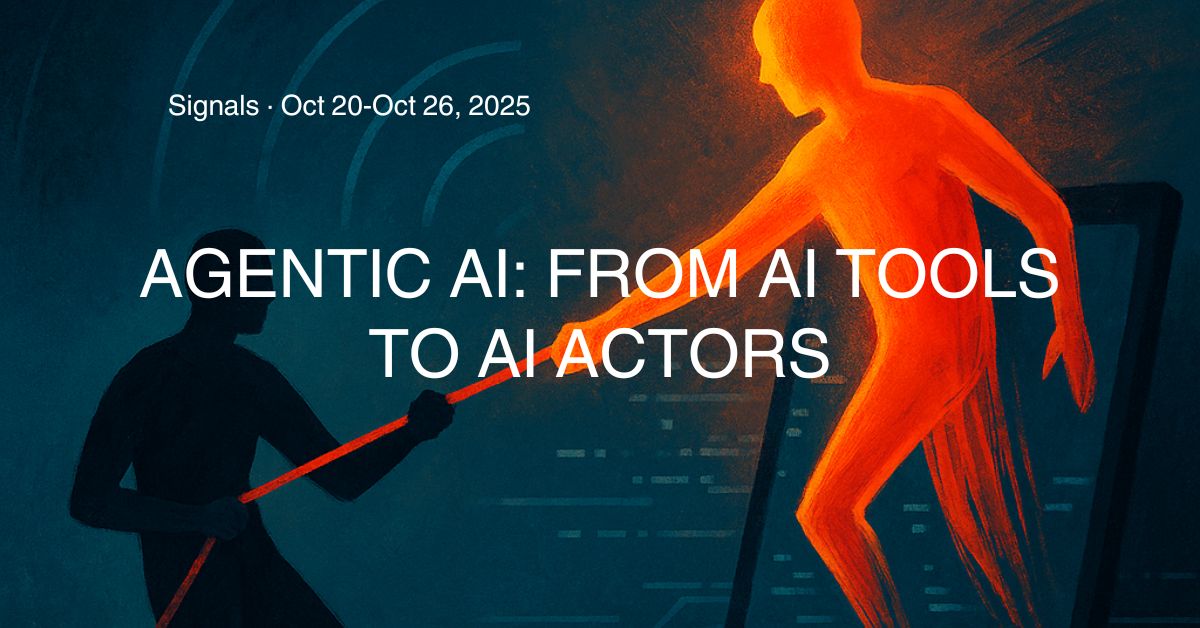- AI systems are starting to act on their own. Not as General Intelligence, yet, but as autonomous agents. What was once automation inside the workflow is becoming an operational actor with its own decision space.
- Gartner’s recent framing of Agentic AI and new demonstrations of prompt-injection and model poisoning are driving security budgets toward provenance tracking, runtime guardrails, and agent-identity controls.
- Vendors are responding with orchestrators, observability tools, and least-privilege policies to contain autonomous execution.
- Investors continue to back platforms that make AI governance tangible: Chainguard’s $280 million round and Filigran’s $58 million expansion underline confidence that controlling AI behavior will define the next growth curve.
- Regulators are tightening expectations. California, NYDFS, and China now treat AI behavior as a managed risk rather than an academic debate. Governance is becoming a key part of the product.
What the Signal Is About
Most organizations are already familiar with AI as a conversational or assistive tool. Best known is ChatGPT that generates text, code, or insights when prompted. Agentic AI describes the next stage: systems that don’t just respond but decide and act. These agents can plan multi-step tasks, interact with APIs, and execute workflows autonomously. They combine reasoning, memory, and tool use to achieve goals with minimal human supervision.
This change alters how AI fits into business operations. A chatbot can be monitored like a feature. An agent behaves more like a user, one that logs in, sends requests, modifies data, or triggers actions. It becomes a participant in the system, not a passive function. That’s why governance is moving from “how accurate is the output?” to “what can this thing do, and under whose authority?”
With that new autonomy comes a new attack surface. Recent demonstrations showed how prompt-injection attacks can manipulate agent behavior in real time and how training-data poisoning with only a few hundred documents can redirect outputs or leak sensitive context. When an agent has system access, those manipulations become operational incidents, not theoretical failures.
As a result, organizations are starting to secure agents the same way they secure people: with identity, least privilege, and continuous monitoring. The controls are changing, but the logic is familiar: visibility, accountability, and containment.
Investor Implications
A distinct investment theme is forming around Agentic AI Security. This is a key infrastructure component that keeps autonomous systems predictable. It overlaps AI safety, identity, and observability, but its business logic is closer to DevSecOps: measurable controls sold as software.
Recent funding rounds confirm momentum. Chainguard raised $280 million to extend software-integrity automation. Filigran secured $58 million to link its threat-intelligence stack with governance agents. Early-stage companies such as Bricklayer and GuardDog AI are experimenting with human-in-the-loop SOC automation.
These aren’t speculative plays; they address an emerging need in the market. And regulators are reinforcing it: California’s updated privacy law now mandates AI risk assessments, and NYDFS requires algorithmic oversight in vendor contracts. Such rules make governance an enduring expense line, once installed, these controls are rarely removed.
We’re expecting consolidation to follow. Security vendors need agent-level visibility to remain relevant. MLOps (Machine Learning Operations) providers will integrate provenance and runtime policies. Cloud platforms will productize compliance-ready “control planes” for enterprise customers.
And capital is rewarding verifiability. Will benefit those who can demonstrate what their AI did, when, and under which policy, and prevent it from repeating the wrong behavior.
Vendor Implications
Procurement criteria are evolving faster than most product roadmaps. Governance once meant quarterly policy reviews. Now, buyers expect architectural evidence: how agent actions are logged, who can override them, and how conflicts are resolved.
Leading vendors are already adjusting:
- Snyk introduced Evo, an agentic orchestrator to prevent prompt-injection and toxic-flow attacks.
- Filigran extended OpenCTI with runtime agent controls and launched OpenGRC for continuous policy mapping.
- Chainguard codified provenance and policy into reusable modules for secure build pipelines.
- Bricklayer and GuardDog AI are piloting “agentic SOC” frameworks that blend automated reasoning with human validation.
The common thread is traceability. As agents gain autonomy, customers want a clear trail of decision origins and constraints. By 2026, runtime auditability and least-privilege execution are likely to appear in standard RFPs.
For vendors, this is less about adding AI features and more about proving command and control. Accountability is becoming a product attribute.
Why It Matters
Agentic AI introduces a subtle but permanent change: software is no longer just processing information, it’s participating in decisions. That participation requires oversight comparable to human operators.
For enterprises, it means the governance layer becomes as strategic as the model itself. For investors, it signals a durable, regulation-anchored market around AI control systems. For vendors, it turns trust from a brand promise into a measurable capability.
We’ve secured users, data, and code. Now the task is to secure intent – defining what digital actors can and cannot do. In this cycle, intelligence is abundant but control is scarce. And that scarcity is where value will concentrate.
